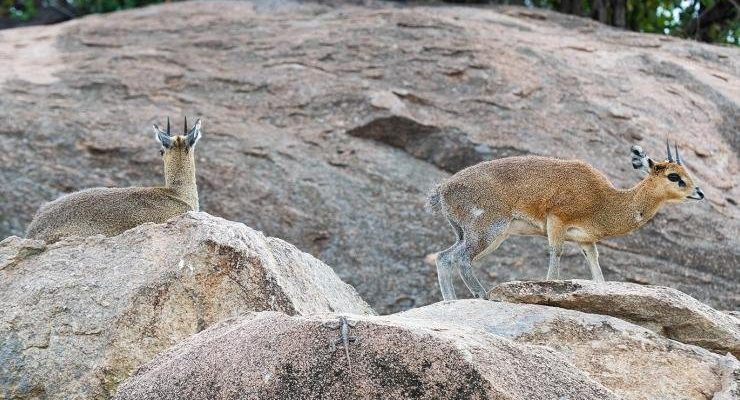
So, what’s their secret? Dik-diks have developed a fascinating combination of physical features and behavioral strategies that allow them to thrive where few others can. Like tiny survival experts, they’ve mastered their environment to find food, evade predators, and deal with extreme temperatures. Let’s dive into the unique traits and habits that make dik-diks true champions of survival.
Physical Adaptations for Survival
One of the first things that strike you about dik-diks is their delicate, small stature. But these little guys are perfectly designed for their environment. For starters, their slender bodies and long legs allow them to maneuver quickly through dense brush. This speed can mean the difference between life and death when evading predators like cheetahs or hyenas.
Size matters too. Being small helps dik-diks minimize their need for water and food. They require far less sustenance than larger animals, which is crucial in arid habitats where resources are scarce. Their lightweight bodies don’t strain as much on limited vegetation, and they can often feed on smaller plants that other animals might overlook.
Additionally, dik-diks possess a unique adaptation in their eyes—the placement of their eyes allows for a wide field of vision to detect movement. This means they can spot predators from a distance, giving them a head start to flee. What might seem like just a cute animal is actually a finely tuned survival machine!
Behavioral Strategies to Find Food
Dik-diks are primarily browsers, meaning they feed on leaves, fruits, and flowers. Here’s where their foraging behavior shines. They are exceptionally selective eaters, grazing primarily in the early morning and late afternoon when the temperatures are cooler. This not only helps them avoid the heat but also keeps them out of view of many predators that are more active during mid-day.
In their diet, they often choose plants that are rich in moisture, helping them to stay hydrated in dry seasons. Interestingly, they can meet many of their water needs through the moisture in these plants, which is a crucial survival tactic in desert-like environments. When food is scarce, dik-diks can also adapt by shifting their diet to include more grasses or even bark.
You might be wondering, how do they know what to eat? Dik-diks possess a keen sense of smell, which guides them to the freshest and most nutrient-dense plants. They also engage in a behavior called “chewing the cud,” similar to cows, allowing them to digest their food more thoroughly and maximize nutrient absorption.
Built-In Defense Mechanisms
Survival isn’t just about finding food; it’s also about avoiding becoming someone else’s meal. While dik-diks might not have the size or strength to fight back, they have several clever defense mechanisms. For one, they rely heavily on their camouflage. Their light brown coats blend seamlessly into the dry grasslands, making it hard for predators to spot them.
When they sense danger, dik-diks tend to stay very still, which helps them avoid detection. If a predator gets too close, they’ll often make a quick dash for safety, utilizing their incredible speed and agility. What’s fascinating is that they have an instinctive ability to zig-zag while running, complicating the pursuit for any hungry hunter.
Additionally, dik-diks are known for their alert calls, which they use to warn each other of approaching dangers. These sharp, whistle-like calls are key to maintaining safety in groups, enhancing their chances of survival even more. It’s a community effort, quite literally, to stay alive in the wild.
Water Conservation Techniques
In harsh environments, access to water can be a real challenge for any animal. However, dik-diks have evolved impressive water conservation techniques. One of the most remarkable features is their ability to tolerate higher levels of dehydration compared to other mammals. This means they can go longer without direct water intake, making survival in their arid habitats more manageable.
Their kidneys are incredibly efficient, filtering waste while minimizing water loss. It’s like having the best high-efficiency appliance for saving water—you get results without using much resource! With this efficiency, dik-diks can often survive periods of drought by simply relying on the moisture present in their plant-based diet.
Moreover, they strategically time their activities to avoid the hottest parts of the day, significantly reducing their water loss through perspiration. This characteristic not only keeps them cool but also allows them to conserve their vital hydration.
Social Behavior and Family Structure
Dik-diks are generally solitary, but they do form pairs, which is fascinating considering their size. These monogamous bonds allow them to enhance their survival chances through cooperative behaviors. When paired, they work together to gather food, watch for predators, and raise their young.
Strong vocalizations play a crucial role in maintaining these partnerships. You’ll often hear them communicate through soft, high-pitched sounds that help maintain their connection. It’s like a little radio network; they’re constantly checking in with each other, ensuring they’re both safe and alert.
When it comes to parenting, dik-dik mothers are incredibly attentive. They give birth to a single calf, which they fiercely protect, hiding them in dense bushes. This protected environment gives the little ones a chance to grow strong while remaining shielded from the prying eyes of predators. It’s a classic example of nurturing survival strategies.
Adaptations to Extreme Temperatures
Extreme temperatures can be a major hurdle for any creature, and dik-diks have adapted to cope with these conditions. Their temperature regulation involves a few key tactics. During hot afternoons, they’ll often seek shade under bushes or trees, conserving energy and keeping cool.
Interestingly, they also have a unique way of cooling down: they often lower their body temperature during the day and raise it at night. This behavior minimizes energy expenditure and helps them cope with the temperature swings typical of their environment. It’s a bit like adjusting the thermostat in your house—you want to stay comfortable without wasting resources.
Their fur also plays a role in temperature regulation. The lighter color of their coats not only provides camouflage but also reflects sunlight, helping to keep them cooler. In contrast, during cooler nights, their fur helps retain heat, making it easier to regulate body temperature throughout the day and night.
So, the next time you think about survival in the wild, remember the dik-dik. These tiny antelopes showcase resilience and adaptability that is truly inspiring. With their ability to navigate harsh environments, find food and water, and evade predators, dik-diks remind us that size doesn’t determine strength or survival.
Their fascinating adaptations present a powerful lesson on living harmoniously with nature. As they continue to thrive in the wild, dik-diks stand as a testament to the wonders of evolution and the intricate dance of life. Next time you’re in the presence of these little survivors, take a moment to appreciate their story. They’re not just cute animals; they’re a vivid reminder of the power of adaptation.

